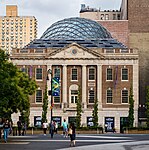New York Film Academy

New York Film Academy – School of Film and Acting (NYFA) is a private for-profit film school and acting school based in New York City, Los Angeles, and Miami. The New York Film Academy was founded in 1992 by Jerry Sherlock, a former film, television and theatre producer. It was originally located at the Tribeca Film Center. In 1994, NYFA moved to 100 East 17th Street, the former Tammany Hall building in the Union Square. After 23 years of occupancy, the academy relocated from Tammany Hall to 17 Battery Place.As of 2012, the school has 400+ employees and over 5,000 students per year (many of them from outside the United States). NYFA offers master, bachelor, and associate degrees, as well as one- and two-year conservatory programs, short-term workshops, and youth programs and summer camps.
Excerpt from the Wikipedia article New York Film Academy (License: CC BY-SA 3.0, Authors, Images).New York Film Academy
East 17th Street, New York Manhattan
Geographical coordinates (GPS) Address Nearby Places Show on map
Geographical coordinates (GPS)
| Latitude | Longitude |
|---|---|
| N 40.736478 ° | E -73.988972 ° |
Address
East 17th Street
East 17th Street
10003 New York, Manhattan
New York, United States
Open on Google Maps








